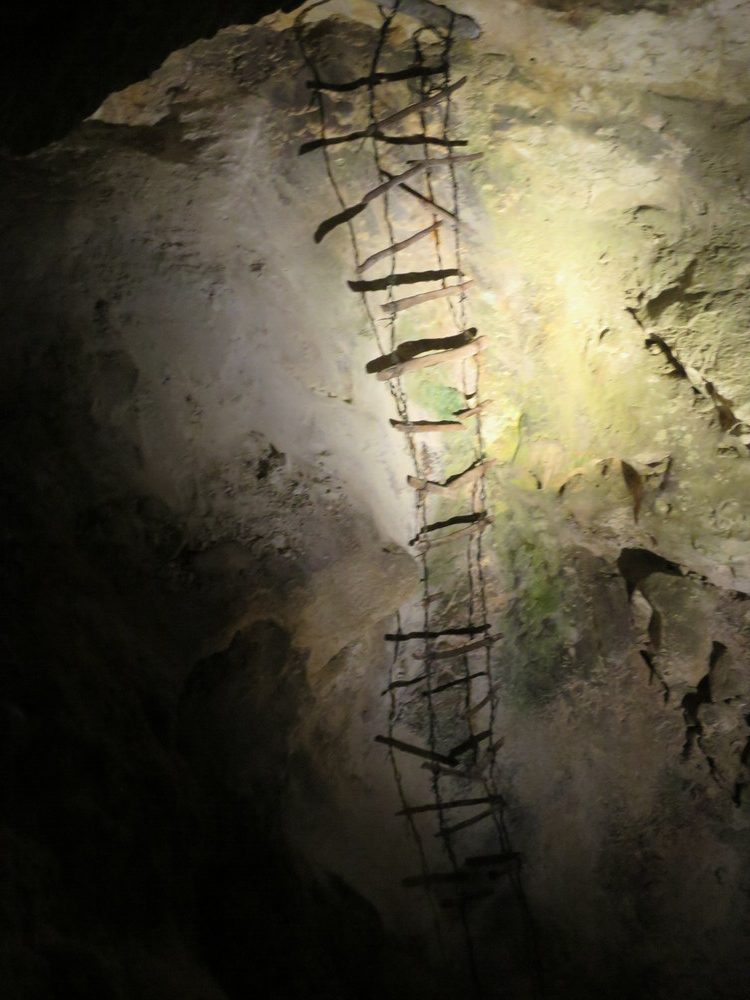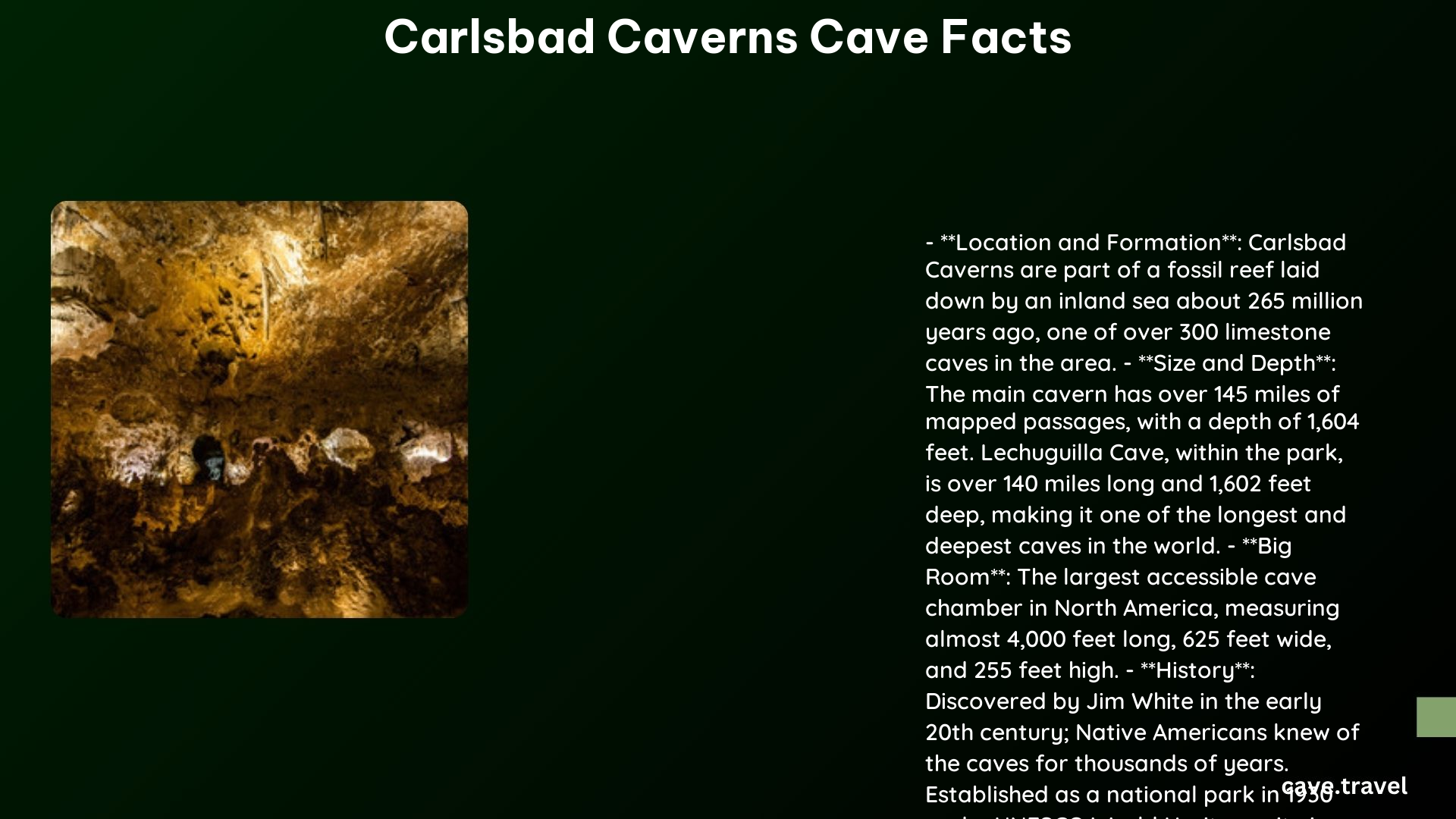Carlsbad Caverns, located in southeastern New Mexico, is a vast underground wonderland of limestone caves. Formed over millions of years, these caverns boast stunning rock formations, diverse ecosystems, and a rich history of exploration. From its constant temperature to its unique wildlife, Carlsbad Caverns offers a fascinating glimpse into the hidden world beneath our feet.
What is the Location and Geological Setting of Carlsbad Caverns?

Carlsbad Caverns National Park is situated in the Guadalupe Mountains of southeastern New Mexico, within the Chihuahuan Desert. The park’s surface elevation is approximately 5,000 feet above sea level. The caverns themselves are part of an ancient reef system formed during the Permian period, roughly 265 million years ago.
Key geological facts:
– The caves are primarily composed of limestone
– They were formed by sulfuric acid dissolution, a unique process among major cave systems
– The Guadalupe Mountains are part of the larger Capitan Reef complex
How Deep and Extensive are the Carlsbad Caverns?

The Carlsbad Caverns system is remarkably deep and extensive, with several notable features:
- Depth: The maximum depth reaches over 1,604 feet (489 meters) in Lechuguilla Cave.
- Natural Entrance: Visitors descend approximately 800 feet from the surface to reach the main chambers.
- Total mapped passages: Over 145 miles of cave passages have been explored and mapped.
| Cave Name | Length | Depth |
|---|---|---|
| Carlsbad Cavern | 30+ miles | 1,027 feet |
| Lechuguilla Cave | 140+ miles | 1,604 feet |
| Spider Cave | 3+ miles | N/A |
| Slaughter Canyon Cave | 2+ miles | N/A |
What are the Unique Environmental Conditions Inside the Caves?
The Carlsbad Caverns maintain a stable environment that differs significantly from the surface conditions:
- Temperature: The caves maintain a constant average temperature of 56°F (13°C) year-round.
- Humidity: The relative humidity in the caves is typically high, often near 100%.
- Darkness: Most areas of the caves are in complete darkness, except for artificially lit tourist sections.
These conditions create a unique ecosystem that supports specialized cave-dwelling organisms.
What Types of Cave Formations Can be Found in Carlsbad Caverns?
Carlsbad Caverns is renowned for its diverse and spectacular speleothems (cave formations). Some of the most notable include:
- Stalactites: Icicle-like formations hanging from the ceiling, some reaching 60 feet in length.
- Stalagmites: Upward-growing formations from the cave floor, with some as tall as six stories (around 62 feet).
- Columns: Formed when stalactites and stalagmites meet and fuse.
- Flowstone: Sheet-like deposits of calcite formed by flowing water.
- Soda straws: Thin, hollow stalactites.
- Draperies: Curtain-like formations hanging from inclined ceilings.
The Big Room, North America’s largest accessible cave chamber, showcases many of these formations, including the famous Hall of Giants and the Crystal Spring Dome.
What Wildlife Inhabits Carlsbad Caverns?
Despite the challenging environment, Carlsbad Caverns supports a diverse array of wildlife:
- Bats: 17 species of bats call the caverns home, with the Brazilian free-tailed bat being the most numerous.
- Cave swallows: These birds nest in the entrance areas of the caves.
- Cave-adapted invertebrates: Including cave crickets, rhadine beetles, and cave centipedes.
- Microorganisms: Various bacteria and fungi thrive in the cave environment.
The bat population is particularly significant, with up to 400,000 Brazilian free-tailed bats emerging from the cave entrance during summer evenings, creating a spectacular natural display.
How Were Carlsbad Caverns Discovered and Explored?
The history of Carlsbad Caverns’ exploration is as fascinating as the caves themselves:
-
Ancient history: Native Americans knew of the caves for thousands of years, with evidence of their presence dating back over 1,000 years.
-
Modern discovery: Jim White, a 16-year-old cowboy, is credited with the modern discovery of the caverns in 1898.
-
Early exploration:
- White used a homemade wire ladder to explore the caves
-
He named many of the rooms and formations still known today
-
Scientific interest:
- National Geographic Society expedition in 1924
-
Establishment as a national monument in 1923
-
National Park status: Designated as Carlsbad Caverns National Park in 1930
-
Ongoing exploration: New passages and caves continue to be discovered, including Lechuguilla Cave in 1986
What are the Most Impressive Chambers and Features of Carlsbad Caverns?
Carlsbad Caverns boasts several awe-inspiring chambers and features:
- The Big Room:
- Largest accessible cave chamber in North America
- Almost 4,000 feet long, 625 feet wide, and 255 feet high at its highest point
-
Contains formations like the Hall of Giants and the Bottomless Pit
-
The Natural Entrance:
- A dramatic 800-foot descent into the cave system
-
Offers a glimpse into the cave’s formation process
-
King’s Palace:
- Features intricate draperies and delicate formations
-
Part of a guided tour showcasing some of the most beautiful areas of the cave
-
Lake of the Clouds:
- The lowest point in the main cavern
-
A crystal-clear underground pool surrounded by stunning formations
-
Lechuguilla Cave:
- While not open to the public, it’s one of the longest and deepest caves in the world
- Known for its unique gypsum and sulfur-based formations
What Scientific Importance Do Carlsbad Caverns Hold?
Carlsbad Caverns is not just a tourist attraction but also a site of significant scientific value:
- Geological studies:
- Provides insights into cave formation processes, particularly sulfuric acid dissolution
-
Offers a window into ancient reef ecosystems
-
Biological research:
- Supports studies on cave ecosystems and adaptations of cave-dwelling organisms
-
Important site for bat research and conservation
-
Paleoclimatology:
- Cave formations provide data on past climate conditions
-
Helps in understanding long-term climate changes
-
Microbiology:
- Home to unique microbial communities adapted to the cave environment
- Potential source of novel microorganisms with biotechnological applications
The ongoing exploration and research at Carlsbad Caverns continue to yield new discoveries and scientific insights, making it a living laboratory for various scientific disciplines.
References:
1. 10 AMAZING Facts About Carlsbad Caverns National Park
2. Carlsbad Caverns National Park – Wikipedia
3. Things to Know About Carlsbad Caverns National Park – AARP
